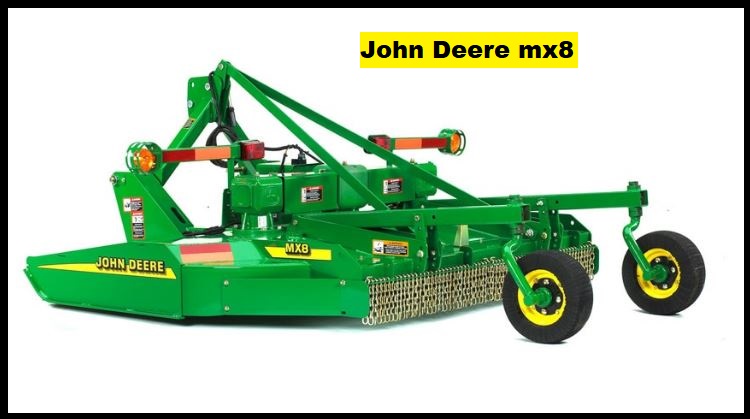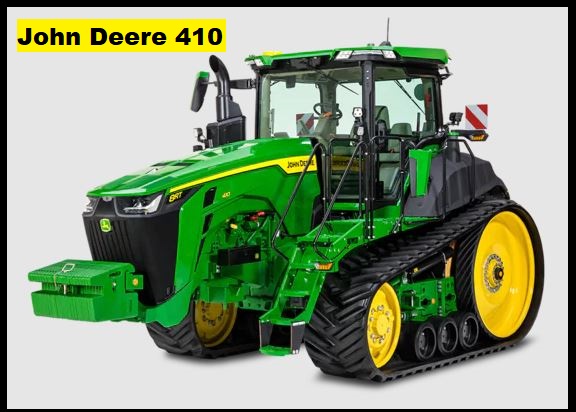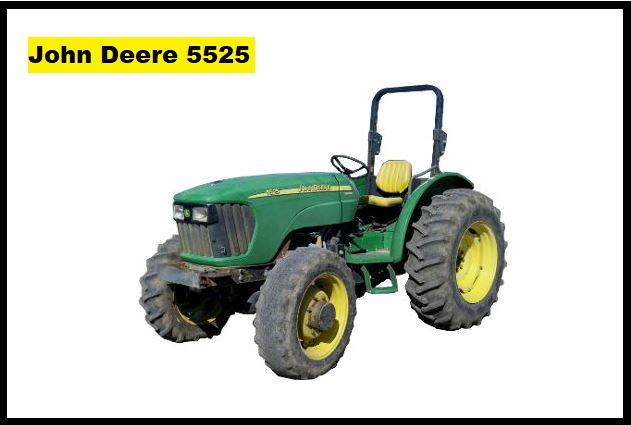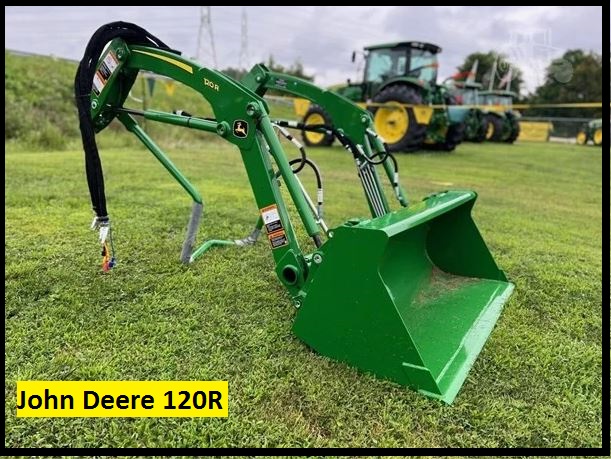The John Deere 2030 2WD utility tractor is part of the Generation II series. From 1971 to 1975, this tractor was manufactured in Dubuque (Iowa), USA, and Mannheim (Baden-Wurttemberg), Germany by John Deere.
The JD 2030 comes with a 3.6L four-cylinder diesel engine or gasoline engine, and one of three transmission options.
The JD 2030 had power assist steering, hydraulic disc brakes, an open operator station, two-post ROPS (optional), and 73.8 Liters (19.5 US gal.; 16.2 Imp. gal) fuel tank.
Also Check
- John deere d130 price
- John deere d140 price
- John deere d105 price
- John deere 6250r price in india
- John deere 1025r specs
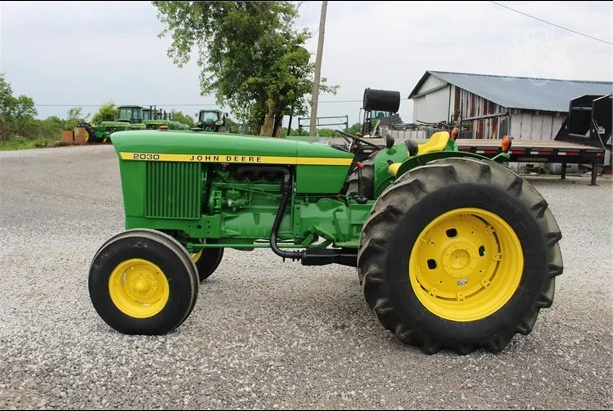
John Deere 2030 Price
Original Price: $9,000 (1975)
John Deere 2030 Horsepower
John Deere 2030 horsepower is 68 hp 50.7 kW
John Deere 2030 Weight
John Deere 2030 Wheelbase is 85.75 inches 217 cm (straight axle) and Weight is 4800 to 5230 pounds
John Deere 2030 Oil Capacity
John Deere 2030 oil capacity is 6 qts 5.7 L
John Deere 2030 Injection Pomp Price
john deere 2030 injection pump price: $1,527.94. Core Charge: $600.00.
John Deere 2030 loader lift capacity
Na
John Deere 2030 Serial Number
- 1972: 134700
- 1973: 157109
- 1974: 187301T (USA)
- 1974: 140000L (Germany)
- 1975: 213360T (USA)
- 1975: 145500L (Germany)
John Deere 2030 Specification
| Maximum power (HP / kW) | 68 HP (50.7 kW) |
| Engine RPM | 2500 rpm |
| Fuel consumption | n.d. |
| Fuel tank capacity | n.d. |
| Max. speed | n.d. |
Engine
| Fuel type | Diesel |
| Engine producer | b.d. |
| Engine model | John Deere |
| Engine type | Diesel (diesel engine) |
| Engine capacity | 3.595 l. |
| Strokes, qty | 4 |
| Cylinders | 4 |
| Compression | n.d. |
| Bore | 102 mm |
| Stroke | 110 mm |
| Maximum torque | n.d. |
| Air filter | n.d. |
| Fuel filter | n.d. |
| Fuel filter chambers, qty | n.d. |
| Oil filter | n.d. |
| Oil pump | n.d. |
| Speed control (control) | n.d. |
| Injection pump | n.d. |
| Injectors | n.d. |
| Injection pressure | n.d. |
| Cooling system | liquid-cooled engine |
| Forced cooling | n.d. |
| Cooler | yes |
| Thermostat | Yes |
| Cooler type | tubular-plate cooler |
| Coolant system capacity | n.d. |
| Clutch | n.d. |
Turbocharge
| Turbocharger | No |
| Dual turbocharger | Not applicable |
| Intercooler | Not applicable |
| Aftercooler | Not applicable |
| Wastegate valve | Not applicable |
| Variable geometry | Not applicable |
| Additional parameters | – |
Electronics
| Supply voltage starter (V) | 12 V |
| Ground | negative ground |
| Battery (V) | 12 V |
| Battery, qty | 1 |
| Charging system | Generator |
| Charging system producer | n.d. |
| Ignition | Manual |
| Rear stop lamp | Yes |
| Rear agricultural lamp | n.d. |
| Cock lamp | No |
PTO
| PTO rpm | 540 rpm |
| PTO control | manual |
Brakes
| ABS | No |
| Brake assist | No |
| Braking system | n.d. |
| Differential | No |
| Brake type | disc brakes, wet brakes, hydraulic |
| Discs | Single |
Dimension
| Weight | from 2177 kg to 2372 kg (depending by model) |
| Length | 3543 mm |
| Height | 2064 mm |
| Width | 1765 mm |
| Clearance | n.d. |
| Front track width | from 1255 mm to 1963 mm |
| Rear track width | from 1372 mm to 1981 mm |
| Wheelbase | 2180 mm |
| Front tires | 6-16 |
| Rear tires | n.d. |
| Max. mass of the trailer without brakes | 1500 kg |
| Max. mass of the trailer with brakes | n.d. |
| Max. axle load | n.d. |
| Max. total weight | n.d. |
| Turning radius | n.d. |
Drive
| Drive system | 4×2, 2WD (depending by model) |
| Additional | one wheel drive |
| Independent Link Suspension | No |
| Articulated suspension | – |
| Crawler drive | No |
| Hydrostatic steering | No |
| Differential | n.d. |
| Steering | rod |
| Front rods | n.d. |
| Rear planetary drives | n.d. |
| Front planetary drives | n.d. |
Hydraulics
| Three-point hitch | n.d. |
| Three-point hitch type | n.d. |
| Three-point hitch performance | n.d. |
| Three-point hitch pressure | n.d. |
| Load Sensing | No |
| Closed | b.d. |
| Central | No |
| Constant flow | No |
| Constant pressure | No |
| Control system | n.d. |
| Two-section distributor | n.d. |
| Quick couplings | n.d. |
| Auto Lift | n.d. |
Transmission
| Synchronous transmission | n.d. |
| Transmission mechanically synchronized | No, electro-hydraulic control |
| PowerShift | Yes |
| PowerShuttle | No |
| Additional | two clutches (dual-clutch gearbox), electro-hydraulic clutch control, fast shifting |
| Forward gears | 8 |
| Reverse gears | 4 |
| Creeper | n.d. |
John Deere 2030 fuel filter
To replace the fuel filter on a John Deere 2030 tractor, follow these steps:
- Turn off the engine and disconnect the negative battery cable.
- Locate the fuel filter assembly on the tractor. It is Typically located on the left side of The engine, near the fuel Tank.
- Place a drain pan beneath the fuel filter assembly to catch any fuel that may spill during the replacement process.
- Loosen the fuel filter assembly using a wrench or pliers, taking care not to damage the assembly.
- Remove the old fuel filter from the assembly and discard it.
- Install a new fuel filter onto the assembly, making sure that it is properly seated and tightened.
John Deere 2030 loader
A front-end loader can help the John Deere 2030 tractor move soil, gravel, and other materials. John Deere 2030 loader info:
Compatibility: John Deere makes numerous 2030 tractor-compatible front-end loaders. These loaders match tractor specs and performance.
Installation: A unique mounting kit attaches the loader to the tractor’s front. The kit comprises 2030 tractor-specific mounts and hardware.
Controls: The operator uses hydraulic valves and levers to control the loader. These controls let the operator raise and lower the loader arms, tilt the bucket, and control other tasks.
Capacity: The tractor’s loader model and specs determine its capacity. John Deere offers loaders with varied lift capacities and bucket sizes for material handling tasks.
Maintenance: The loader’s maintenance routine should include lubricating moving parts, inspecting hydraulic lines and connections, and checking for wear and damage.
John Deere 2030 Problems With Solution
Here are some common problems that can occur with a John Deere 2030 tractor and their potential solutions:
Engine starting problems – If the engine is difficult to start or won’t start, check the battery for proper charge and connections. Check the fuel filter for clogs or contamination. If the problem persists, it could be a sign of a faulty starter or fuel pump.
Hydraulic Pump system problems – If the hydraulic system is not functioning properly, check the hydraulic fluid level and condition. Look for leaks in the hoses and fittings. If the problem persists, it could be a sign of a worn hydraulic pump or damaged hydraulic cylinder.
Transmission problems – If the tractor has difficulty shifting gears or loses power while driving, it could be a sign of low or contaminated transmission fluid. Check the transmission fluid level and condition. If the problem persists, it could be a sign of a faulty transmission pump or worn gears.
Electrical problems – If the tractor’s electrical system is not functioning properly, check the fuses, wiring, and connections for signs of damage or corrosion. If the problem persists, it could be a sign of a faulty alternator or starter.
Steering problems – If the tractor’s steering is difficult or loose, check the power steering fluid level and condition. Look for leaks in the hoses and fittings. If the problem persists, it could be a sign of a worn steering gear or hydraulic cylinder.
John Deere 2030 Review
The John Deere 2030, although a discontinued model, had its time in the spotlight as a popular utility tractor. It was in production from 1972 to 1981 and earned a reputation for its reliability, durability, and versatility.
Equipped with a 65-horsepower diesel engine and a three-range manual transmission, the 2030 had the power and flexibility needed for a wide range of tasks. Its hydraulic system, capable of operating up to two remote cylinders, added to its versatility, making it suitable for mowing, tilling, loading, and snow removal, among other applications.
For more details check out the YouTube video
Official site: https: www.deere.com
John Deere 2030 FAQ
what loader fits a john deere 2030?
The “matched” John Deere loader for 2030 is a 145 loader. They come with independent controls and are fully hydraulic, ie no mechanical dump.
What is the John Deere 2030 tractor?
The John Deere 2030 is a 2WD or 4WD utility tractor that was manufactured by John Deere in the 1970s.
What is the engine size of the John Deere 2030?
The John Deere 2030 is equipped with a 3.6-liter, 4-cylinder diesel engine that produces 60 horsepower (HP) at the PTO (power take-off).
Is John Deere 2030 a good or brand tractor?
John Deere 2030 is a good tractor that ranks highest among brands of tractors for overall loyalty.
What is the weight of the John Deere 2030 tractor?
The weight of the John Deere 2030 tractor depends on the model and configuration, but it typically ranges from 5,340 to 6,110 pounds.
What are the dimensions of the John Deere 2030 tractor?
The length of the John Deere 2030 tractor is 141.7 inches, the width is 67.3 inches, and the height is 100.8 inches (with the ROPS, or roll-over protection system, installed).
What is the maximum lift capacity of the John Deere 2030?
The maximum lift capacity of the John Deere 2030 depends on the model and configuration of the tractor, as well as the implement being used.
What are some common problems with the John Deere 2030 tractor?
Common problems with the John Deere 2030 tractor include engine starting problems, hydraulic system problems, transmission problems, electrical problems, and steering problems.
How do I troubleshoot transmission problems on my John Deere 2030 tractor?
To troubleshoot transmission problems on your John Deere 2030 tractor, check the transmission fluid level and condition, look for leaks in the hoses and fittings, and inspect the transmission pump and gears.
How do I troubleshoot electrical problems on my John Deere 2030 tractor?
To troubleshoot electrical problems on your John Deere 2030 tractor, check the fuses, wiring, and connections for signs of damage or corrosion, and inspect the alternator and starter.
What type of fuel does the John Deere 2030 use?
The John Deere 2030 uses diesel fuel.
What type of transmission does the John Deere 2030 have?
The John Deere 2030 can be equipped with a synchromesh transmission with eight forward and two reverse gears.
Can I install a loader on my John Deere 2030 tractor?
Yes, the John Deere 2030 can be equipped with a front-end loader too.
This article I have created to give you the complete information about the John Deere 4410 Specs, Price with its Review.
Check out the given details which help you to know about the John Deere 4410 Specs, Price with its Review.
For more information visit our website: Commercialvehicleinfo.com

